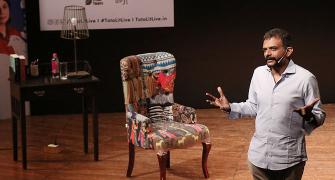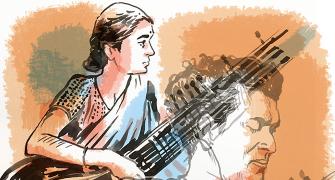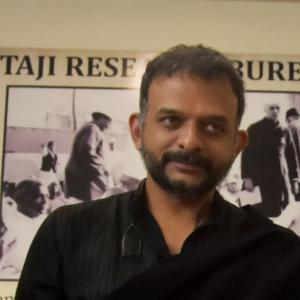They all seem to forget that the Music Academy is as much an independent institution as T M Krishna is an individual musician.
In drawing those red lines for the Academy management, they do not seem to recognise that they too have crossed a red line themselves, points out N Sathiya Moorthy.

The row involving the prestigious Madras Music Academy, considered by many as the key promoter and protector of traditional Carnatic music, and iconoclast vocalist T M Krishna refuses to die down any time soon.
Rather, the controversy is not about either of them, but about those that have criticised the Academy for choosing the singer for the conferment of the annual 'Sangeetha Kalanidhi' title -- not because he did not measure up but because he identified himself with yesteryear social reformer Periyar E V R Naicker, who ran down Hindu gods and Brahmins.
By tradition, whoever is chosen for the year's title gets to preside over the subsequent annual music festival at the Academy held in December.
Those who have now announced their boycott of the month-long programme at the Academy this yearend have clearly indicated that they had no issues with T M Krishna's music prowess, but his social initiatives and messaging which began when he declared a few years ago that he would not perform ticketed concert-singing any more.
Since then, he has been rendering formal and informal concerts on the city's Besant Nagar beach, and also for the poor and downtrodden, in what is described as an 'inclusive way'.
The problem is that all those that have protested against the Academy have a conservative Brahmin background.
So does T M Krishna, who is an Iyengar-Brahmin, a grandnephew of the late Union finance minister T T Krishnamachari.
Beginning with the founding fathers, most promoters and officer-bearers of the Academy too have been Brahmins.
The present Academy president N Murali, a joint-owner and director of The Hindu newspaper group, is also an Iyengar-Brahmin.
The Academy might not have dealt with social issues of the kind Krishna has been seeking to flag, but it is to be remembered that it was founded as an offshoot of the nation's greatest socio-political movement, the freedom movement, less than 100 years ago, in 1928.
A year earlier, the organisers of the Madras session of the Indian National Congress had arranged Carnatic music programmes in the evenings, for the benefit of the delegates.
It was an extension of Gandhiji's idea of reviving and promoting indigenous art forms.
It was not only music, but even handicrafts from rural India were on display at an exhibition-cum-demonstration at the site where the state Congress headquarters, Satyamurti Bhavan, now stands.
When it was music, the organisers, who were mostly urban, upper-middle class Brahmins, did not possibly know about the existence of folk music and folk dances.
Why, even the sacred of all musical instruments for them, the nadaswaram, was not allowed to perform on the dais, long after the Academy and its annual music festival became institutionalised.
Arguably, those that accepted Gandhiji's leadership should have accepted his embracing a caste-free society, but that was not the case in the Academy -- which over time evolved into a puritanical institution for promoting Carnatic music, which mostly praised Hindu gods and goddesses, and mostly in Telugu (Chennai, then Madras, was an extension of the Telugu country until after the Linguistic Reorganisation of States in 1956).
Puritans revelled in the idea, until the likes of philanthropist-businessman Rajah Sir Annamalai Chettiar and his son Rajah Muthiah Chettiar, founded the Tamil Isai Sangam in 1940, conducting parallel annual music festivals, where all renderings had to be in the language.
It is another matter that the Music Academy had invited both of them in different years to preside over the annual festival.
It still took years for vocalists and instrumentalists, going also beyond the nadaswaram vidwans, to render melodious songs in Tamil, set to music, mostly by lyricists like freedom-fighter Subramania Bharati, Arunachala Kavirayar, Oothukadu Venkatasubbiyer and Papanasam Sivan.
While they formed the core and content of the concerts in Tamil Isai Sangam, at the Academy -- and other sabhas that had sprouted in between -- Carnatic music songs in Tamil were relegated to the tail end of the programme, called thukkada.
There was a time when self-styled puritanical members of the audience used to leave the concert hall when thukkada started, as if they did not approve of the 'interpolation' -- but not anymore.
Once the Academy became an organised institution, it took some time to shed their casteist inhibitions, for it to invite nadaswaram vidwans (mostly from the lower rungs of society, however great they be) to perform on the dais.
So was the case of inviting women to perform. It started in 1934, with Rugmani Rajagopalan, grandmother of Sanjay Subramanyan, one of the present-day greats.

The same applies to non-Brahmin singers, who included M M Dandapani Deekshidar, Madurai Somu and M S Subbulakshmi, or MS, Sirkazhi Govindarajan, his son Sirkazhi Sivachidambaram, and many others.
There were also the likes of Balasaraswati, the Bharata Natyam danseuse, and many others who have followed in her footsteps -- caste, creed, and at times, religion no bar.
MS, the 'eternal queen of Carnatic music', was also the first woman the Academy honoured with a Sangeetha Kalanidhi.
Cutting across regions and languages, wherever South Indian Hindus reside, their day begins with only her rendering of the Sri Venkatesa Suprabatam in Telugu.
In Tamil Nadu, this is either being accompanied or replaced by the Kanda Sashti Kavasam by the Sulamangalam Sisters, an equally divine and musical rendering on Lord Murugan in Tamil.
That way, the organic evolution of the Music Academy has since included shedding the exclusivity of Carnatic music, to include Hindustani music concerts, especially one on December 31, New Year's Eve.
Nowadays, Saint Purandaradasa's Kannada kritis, and Abhangs in Marathi, also form part of the repertoire of any major Carnatic music concert.
Incidentally, Purandaradasa (1484-1564) is considered among the early proponents of Carnatic music.
It is possible that T M Krishna imbibed social consciousness from his mother and maternal uncle, who used to run a school for tribal children at Anaikatti, near Coimbatore.
For a product of the high-end 'The School' run by the J Krishnamurti Foundation, the contrasts should have been striking.
So should have been his years as a graduate student at the tradition-bound Vivekananda College in Madras -- known for its bright faculty members and students alike, all the same dominated by the Brahmin community, for no particular reason or purportedly pronounced bias.
The transformation, like that of Krishna, was bound to happen.
But if someone went beyond their limited criticism of the Academy management, then there is the question if Carnatic music was only about renderings in Telugu, most of them penned by the Trinity of Tyagaraja, Muthuswami Dikshidar and Shyama Shastri -- and also the Sanskrit renderings by Swati Tirunal Maharaja of the erstwhile Travancore kingdom.
Incidentally, all four of them belonged to the 17th and 18th centuries.
Compared to them, Annamacharya, who was the earliest exponent of samkirtans, lived in the 15th century and passed away in 1503.
Yet, it is Tyagaraja who holds the unique distinction of being deified on his death anniversary every year, with traditional pujas and five days of musical renderings in Tiruvaiyaru, where his samadhi is located.
It reaches a crescendo with the group rendering of Tyagaraja's famous five compositions, called the Pancharatna Kritis, on the fifth and final day (in January-February, coinciding with the Tamil month of Thai).
If so, what was the equivalent of Carnatic music and concert like in the era before these great composers, who are often deified by both religious devotees and rasikas, or connoisseurs (external link), alike?
Whatever be the trends in the adjoining states, kings and zamindars used to be the patrons of fine arts.
There existed the Devadasi (servant of the god) system, which started with the early practice of families dedicating a female child to the local temple, to serve the deity, exclusively.
From a young age, they were trained in dance, known as sadhir, and music, which going by available records, if any, should have been in Tamil -- not in Telugu or Sanskrit.
Tamil twin-epics of Silappadikaram and Manimekalai speak about Devadasis and have always mentioned their renderings in Tamil.
The former is said to belong to the Sangamera, two thousand years ago, and the latter, anytime before the 6th century CE.
Stone inscriptions in the famous Big Temple in Thanjavur, built by Rajaraja Chola in the 11th century, detail payments to be made to the temple's Devadasis, among other professionals like priests, accountants, gardeners, etc, etc, etc.
All of it only goes to show that prior to the advent of Carnatic music as is known at present, there was Tamil music in these parts, to whose repertoire the Devadasi singers of those days added the religious hymns of the saint-poets of Saivism and Vaishnavism, all of them set to music.
There are those who argue that only after the abolition of the Devadasi system by the law, Carnatic music in its present form came to be conferred 'respectability'.

What Lord's is to cricket and Wimbledon is to tennis, the Music Academy is to Carnatic music.
Like the other two, it too has faced periodic controversies, including those on the choice for the annual honour.
There was even a controversy when veteran Ariyakudi Ramanuja Iyengar introduced the current format of rendering more songs within the allotted time -- and less alapana or elaboration of the musical notes, compared to earlier.
On another occasion, Ariyakudi reportedly had problems about a junior in M S Subbulakshmi getting greater importance at the Academy, and started patronising the Tamil Isai Sangam.
As if to prove a point, he wanted the Academy to pay him at least one rupee more than MS, as concert fees.
On another occasion, veena maestro S Balachander questioned the conferment of the Sangeetha Kalanidhi on renowned vocalist Balamurali Krishna, for among other things, 'inventing a new raga.'
He argued that rearrangement of the Melakartha Ragas, or the basic ragas, numbering 72, would always produce a new raga -- and that was not an achievement.
Balachander had a separate problem with another of the greatest, Semmangudi Srinivasa Iyer, over the latter's music-centric biography of Maharaja Swati Tirunal.
At a young age, Semmangudi became the court vidwan of the Travancore kingdom.
Balachander questioned the very basis of the traditional belief about the authorship of the Swati Tirunal kritis.
With 'internal evidence', he argued that Thanjavur Vadivelu Pillai of the famous 'Thanjavur Quartet' brothers, who was Swati Tirunal's court musician, was the real author of those kritis.
Such controversies did not stop there, it is said. Maharajapuram Viswanatha Iyer was reportedly upset that his disciple Semmangudi Srinivasa Iyer was given the equally or even more prestigious Sangeet Natak Akademi Award two years before him, in 1953.
Then, there were the undiscussed and undisclosed ego clashes when vocalists stopped partnering with accompanists who were rank seniors and/or better performers.
Included in the list of this class of accompanists were T N Krishnan, Lalgudi Jayaraman and M S Gopalakrishnan (all of them violinists), Karaikudi Mani and Umayalpuram Sivaraman (mridangists), among a host of others.
In his time a generation earlier, the indomitable Palghat Mani won the battle for mridangists to have a microphone, which the vocalists resented because they feared that an amplified mridangam score would drown their voice.
Their fears were unfounded, and the precedent set by Palghat Mani prevails.
Today, the question is how far such evolutions and controversies can go. Should it stop with form, or can it include content?
That is the larger controversy involving T M Krishna all about.
Whether Carnatic music concerts should restrict themselves to signing the praise of Hindu gods or could they include those from other religions.
Here again, T M Krishna broke the tradition by rendering the praise of Christ and Allah in Tamil lyrics, set to Carnatic notes.
Possibly, two-plus decades before the birth of the Music Academy, church choirs had begun singing the hymns written by Henry Alfred Krishnapillai, a converted Christian, who died in 1900.
The present controversy is not about T M Krishna's rendering of Sindhikka Sonnavar Periyar or 'Periyar asked us to think', last year.
Instead, it is about the Music Academy honouring him that the critics went after.
Surprisingly, they all belong to the younger age group, where greater orthodoxy of the kind was seen as not being an influencing factor.
Seniors or veterans, if they have any reservations, have not spoken up.
Likewise, there are few from within the music community who have defended T M Krishna.
Among them is Chinmayi Sripada, who is an up and coming playback singer in Tamil filmdom.
Incidentally, Chinmayi, who continues to spearhead the 'Me2 movement' in Tamil Nadu, took up the case of some female shishyas, or disciples, 'Chitra Veena' Ravikiran has since returned his Sangeetha Kalanidhi award to the Academy.
Another of the staunch critics, Dushyanth Sridhar, has publicly cancelled his New Year's day religious discourse at the Academy in 2025, months from now.
A BTech-holder from BITS-Pilani, who gave up his career in chemical engineering and took to full-time religious discourse a few years ago, Dushyanth's public lectures, YouTube programmes and TV talk shows have been taking not only a pro-Hindutva line but also a pro-Modi line, so to say. That has added an avoidable political angle to his criticism.
The same could be said also about the famed Harikatha exponent Vishaka Hari, though she stops with hinting at her political preferences during the course of her discourses -- and not on TV talk shows and interviews, in the garb of defending the faith.

The problem for Krishna is his activism -- and activism of a particular kind and direction.
As explained, there are those who take a divergent line themselves, and they are among those who have targeted Krishna.
To be fair, the Trichur Brothers and the Ranjini-Gayathri Sisters who launched the criticism against the Music Academy do not seem to have expressed their preference for one party or leader -- but their preference for a particular social norm is as evident as that of T M Krishna.
Yet, there is no denying Carnatic music practitioners and rasikas the world over looking up to the Madras Music Academy as the holiest of shrines -- and as their own.
They have also attached great divinity to Carnatic music, only because it has traditionally been singing the praise of Hindu gods.
But when T M Krishna cited one of Tyagaraja's kritis, to argue that the Lord is not in temples but in everyone's heart, it coincided with the Ayodhya temple inauguration, and the politico-religious types were piqued.
Against this background, they all seem to forget that the Music Academy is as much an independent institution as T M Krishna is an individual musician.
Because they have identified themselves overmuch with the Academy, they are unable to stomach what they (alone) have unilaterally concluded is a sacrilege that none of them, starting with the institution, can live with.
In drawing those red lines for the Academy management, they do not even seem to recognise that they too have crossed a red line, themselves.
It is like an assortment of voters preferring the same party, leader or candidate for an assortment of causes and aspirations.
And when the man they had voted for is elected and he does not meet their own expectations -- which he did not know, or even wanted to know -- the voters are disheartened.
The parallel is striking, but that is also the reality!
N Sathiya Moorthy, veteran journalist and author, is a Chennai-based policy analyst and political commentator.
Feature Presentation: Aslam Hunani/Rediff.com









